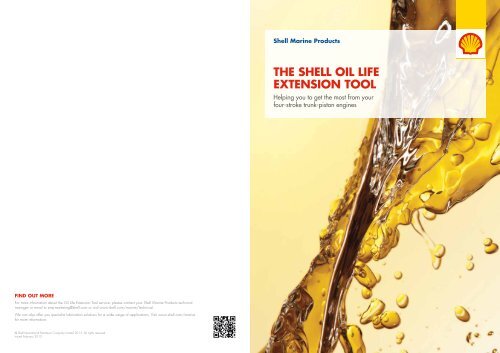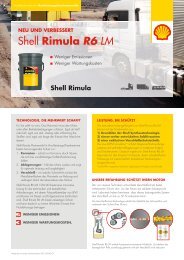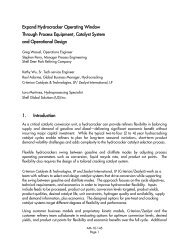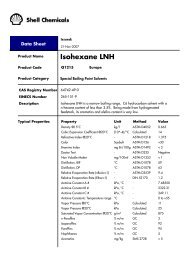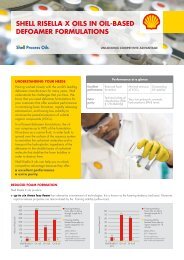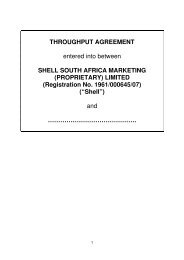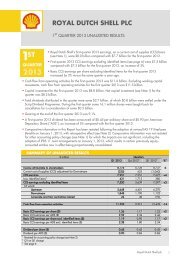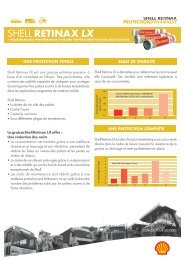The Shell Oil life exTenSiOn TOOl
The Shell Oil life exTenSiOn TOOl
The Shell Oil life exTenSiOn TOOl
You also want an ePaper? Increase the reach of your titles
YUMPU automatically turns print PDFs into web optimized ePapers that Google loves.
<strong>Shell</strong> Marine Products<br />
<strong>The</strong> <strong>Shell</strong> <strong>Oil</strong> Life<br />
Extension Tool<br />
Helping you to get the most from your<br />
four‐stroke trunk-piston engines<br />
Find out more<br />
For more information about the <strong>Oil</strong> Life Extension Tool service, please contact your <strong>Shell</strong> Marine Products technical<br />
manager or email to smp-marketing@shell.com or visit www.shell.com/marine/technical.<br />
We can also offer you specialist lubrication solutions for a wide range of applications. Visit www.shell.com/marine<br />
for more information.<br />
© <strong>Shell</strong> International Petroleum Company Limited 2013. All rights reserved.<br />
Issued February 2013
<strong>The</strong> <strong>Shell</strong> <strong>Oil</strong> Life Extension Tool<br />
<strong>The</strong> properties of oil change when it is exposed to the working conditions in an engine and<br />
these changes have a direct effect on engine performance. <strong>The</strong> concept of oil stress helps us to<br />
understand why these changes occur, to assess the extent of the changes, and to identify the<br />
factors responsible. <strong>The</strong> <strong>Shell</strong> <strong>Oil</strong> Life Extension Tool uses oil stress theory to help you optimise the<br />
operation of your four-stroke trunk-piston engines with <strong>Shell</strong> Argina oils.<br />
Understanding oil stress in<br />
medium‐speed engines<br />
<strong>The</strong>re are three principal stresses that have an impact on the<br />
performance of four-stroke trunk-piston engine oils: acid stress,<br />
thermal stress and asphaltene stress. <strong>The</strong> level of oil stress in an<br />
engine depends on the operating conditions, the volume of oil that<br />
is available to absorb the stresses and the frequency with which the<br />
oil is changed.<br />
Recent trends in the design and operation of four-stroke trunk-piston<br />
engines include higher-performing engine designs, a wider variety of<br />
operating conditions and lower-quality fuels of increasingly variable<br />
composition. Each of these changes can, if not correctly managed,<br />
contribute to increased oil stress, which has a direct influence on<br />
engine performance and operational costs. High oil stress can<br />
■■<br />
reduce engine reliability<br />
■■<br />
shorten oil <strong>life</strong><br />
■■<br />
shorten the <strong>life</strong> of your engine components<br />
■■<br />
increase running costs.<br />
<strong>Shell</strong> researchers have extensively tested engines and lubricants<br />
under extreme conditions in order to understand and define various<br />
aspects of oil stress. This research has enabled <strong>Shell</strong> to devise better<br />
ways to manage oil stress and so improve engine reliability, extend<br />
component <strong>life</strong> and reduce operating costs.<br />
Key to controlling oil stress is selecting a lubricant that offers the<br />
best all‐round stress management performance. <strong>Shell</strong> has used the<br />
knowledge gained from its research to develop the <strong>Shell</strong> Argina<br />
range of oils to address the challenges of acid, thermal and<br />
asphaltene stress.<br />
Introducing the <strong>Shell</strong> <strong>Oil</strong> Life<br />
Extension Tool<br />
<strong>Shell</strong>’s <strong>Oil</strong> Life Extension Tool uses oil stress theory to help customers<br />
who want to get the best out of <strong>Shell</strong> Argina or who are face significant<br />
challenges in the operation of their four-stroke trunk-piston engines.<br />
Using a proven methodology, the <strong>Oil</strong> Life Extension Tool has<br />
applications across a wide range of marine settings and scenarios.<br />
Experience gained in applying the <strong>Oil</strong> Life Extension Tool has shown<br />
that it can play a significant role in addressing the issues associated<br />
with oil stress and extending the oil-drain interval.<br />
benefits of the <strong>Oil</strong> Life Extension Tool<br />
<strong>Oil</strong> stress levels are influenced by several factors, for example:<br />
■■<br />
the power developed by the engine<br />
■■<br />
the sulphur content of the fuel<br />
■■<br />
the lubricating sump volume<br />
■■<br />
the lubricating oil consumption rate.<br />
Using values for these inputs in the <strong>Oil</strong> Life Extension Tool, <strong>Shell</strong><br />
representatives can provide tailored lubrication advice on oil stress<br />
management in four-stroke trunk-piston engines. This helps engine<br />
operators to<br />
■■<br />
select the grade of <strong>Shell</strong> Argina that matches the oil stress in<br />
their engines<br />
■■<br />
achieve operational reliability<br />
■■<br />
reduce lubrication costs<br />
■■<br />
find greater peace of mind.<br />
When can the <strong>Oil</strong> Life Extension<br />
Tool help?<br />
<strong>The</strong> <strong>Oil</strong> Life Extension Tool can help marine engine operators who<br />
■■<br />
have problems maintaining the quality of their oil charge.<br />
■■<br />
want to help ensure that they are minimising lubrication costs while<br />
maintaining the operational health of the engine.<br />
How do operators use the <strong>Oil</strong> Life<br />
Extension Tool?<br />
<strong>The</strong> oil change interval for trunk-piston engines is set by the<br />
equipment manufacturers’ recommendations on drain interval.<br />
However, monitoring key indicators such as residual base number<br />
(BN) and viscosity through used oil analysis and setting the limits<br />
that trigger oil change can extend the interval. It is also known that<br />
the residual BN of an oil change in a trunk piston engine sump<br />
corresponds very closely to the build-up of oil stress factors at any<br />
given time. <strong>The</strong> <strong>Oil</strong> Life Extension Tool helps operators to identify the<br />
optimal oil-drain interval.<br />
<strong>The</strong> <strong>Oil</strong> Life Extension Tool models the time-based decay of properties<br />
such as oil charge residual BN to assess and compare the lubrication<br />
costs of possible oil replenishment strategies over a year or more of<br />
engine operation. <strong>The</strong> options that can be modelled include<br />
■■<br />
selecting different <strong>Shell</strong> Argina grades to predict their effect on the<br />
oil-drain interval<br />
■■<br />
conducting complete oil changes once safe limits are triggered<br />
■■<br />
conducting partial oil changes<br />
■■<br />
using sweetening (draining and replenishment of small, calculated<br />
amounts of oil charge at specified intervals) to delay full or partial<br />
oil changes.<br />
Operators can use the <strong>Oil</strong> Life Extension Tool in three distinct<br />
ways. At the first level, the <strong>Oil</strong> Life Extension Tool enables users to<br />
estimate the BN as a function of the running hours for <strong>Shell</strong> Argina<br />
lubricants and to create a running hours versus oil BN curve using<br />
simple technical information such as engine output, oil volume in<br />
circulation, oil consumption and the sulphur content of the fuel.<br />
BN depletion graph<br />
MV<br />
BN<br />
Sirius,<br />
depletion<br />
Wärtsilä<br />
graph<br />
6L38A<br />
MV Sirius, Wärtsilä 6L38A<br />
55<br />
55<br />
50<br />
50<br />
45<br />
45<br />
40<br />
40<br />
35<br />
35<br />
30<br />
30<br />
25<br />
25<br />
20<br />
20<br />
15<br />
15<br />
10<br />
10<br />
5<br />
5<br />
0<br />
0 0 1,000 2,000 3,000 4,000 5,000 6,000 7,000 8,000<br />
0 1,000 2,000 3,000 4,000 5,000 6,000 7,000 8,000<br />
<strong>Oil</strong> usage time (h)<br />
<strong>Oil</strong> usage time (h)<br />
BN rejection limit<br />
<strong>Shell</strong> BN rejection Argina XL, limit fresh oil BN: 50, fuel S: 2.3%, SLOC: 0.36 g/kWh, eq. BN: 16.3<br />
<strong>Shell</strong> Argina X, XL, fresh fresh oil oil BN: BN: 40, 50, fuel fuel S: S: 2.3%, SLOC: 0.36 0.36 g/kWh, eq. eq. BN: BN: 6.3 16.3<br />
<strong>Shell</strong> Argina X, fresh oil BN: 40, fuel S: 2.3%, SLOC: 0.36 g/kWh, eq. BN: 6.3<br />
BN BN (mgKOH/g)<br />
BN depletion graph<br />
MV<br />
BN<br />
Sirius,<br />
depletion<br />
Wärtsilä<br />
graph<br />
6L38A<br />
MV Sirius, Wärtsilä 6L38A<br />
55<br />
55<br />
50<br />
50<br />
45<br />
45<br />
40<br />
40<br />
35<br />
35<br />
30<br />
30<br />
25<br />
25<br />
20<br />
20<br />
15<br />
15<br />
10<br />
10<br />
5<br />
5<br />
0<br />
0 0 1,000 2,000 3,000 4,000 5,000 6,000 7,000 8,000<br />
0 1,000 2,000 3,000 4,000 5,000 6,000 7,000 8,000<br />
<strong>Oil</strong> usage time (h)<br />
<strong>Oil</strong> usage time (h)<br />
BN rejection limit<br />
<strong>Shell</strong> BN rejection Argina XL, limit fresh oil BN: 50, fuel S: 2.3%, SLOC: 0.36 g/kWh, eq. BN: 16.3<br />
Measured <strong>Shell</strong> Argina XL, fresh oil BN: 50, fuel S: 2.3%, SLOC: 0.36 g/kWh, eq. BN: 16.3<br />
Measured<br />
BN BN (mgKOH/g)<br />
Cost of lubrication over observed period<br />
MV<br />
Cost<br />
Sirius,<br />
of lubrication<br />
Wärtsilä 6L38A<br />
over observed period<br />
MV Sirius, Wärtsilä 6L38A<br />
55<br />
55<br />
50<br />
50<br />
45<br />
BN (mgKO BN 25 20<br />
20 15<br />
15 10<br />
10 5<br />
50<br />
0 1,000<br />
0<br />
0 1,000<br />
2,000 3,000 4,000 5,000 6,000 7,000 8,000<br />
2,000 3,000<br />
<strong>Oil</strong><br />
4,000<br />
usage time<br />
5,000<br />
(h)<br />
6,000 7,000 8,000<br />
<strong>The</strong>re is also the option of inputting measured BN values on the<br />
BN rejection limit<br />
<strong>Oil</strong> usage time (h)<br />
estimated <strong>Shell</strong> Argina BN decay XL, fresh oil curve BN: 50, so fuel that S: operators 2.3%, SLOC: 0.36 can g/kWh, gain confidence<br />
eq. BN: 16.3<br />
BN<br />
in the <strong>Shell</strong><br />
rejection<br />
effectiveness Argina<br />
limit<br />
X, fresh of oil the BN: tool. 40, fuel S: 2.3%, SLOC: 0.36 g/kWh, eq. BN: 6.3<br />
<strong>Shell</strong> Argina XL, fresh oil BN: 50, fuel S: 2.3%, SLOC: 0.36 g/kWh, eq. BN: 16.3<br />
<strong>Shell</strong> Argina X, fresh oil BN: 40, fuel S: 2.3%, SLOC: 0.36 g/kWh, eq. BN: 6.3<br />
At the second level, the <strong>Oil</strong> Life Extension Tool can model lubricant<br />
BN depletion graph<br />
expenditure based on input values for lubricant unit price,<br />
normal BN<br />
MV<br />
depletion<br />
Sirius, Wärtsilä<br />
consumption graph<br />
6L38A<br />
(replacing what is consumed) and artificial<br />
MV<br />
consumption.<br />
55 Sirius, Wärtsilä 6L38A<br />
This can help operators decide to improve the oil<br />
quality 55 50<br />
by either complete and regular oil changes or more frequent<br />
oil 50 sweetening.<br />
45<br />
45 40<br />
<strong>The</strong> third level option for the <strong>Oil</strong> Life Extension Tool calculates the<br />
40 35<br />
lubrication cost if the engine operator does not conduct a partial oil<br />
35 30<br />
change but increases the oil-sweetening rate. Sweetening involves<br />
30 25<br />
draining a small amount of oil regularly (daily or every few days)<br />
25 20<br />
before topping up. This introduces more fresh oil into the engine<br />
20 15<br />
than would be required to compensate for the natural consumption<br />
15 10<br />
of the engine and will result in the lowest cost of lubrication at a<br />
10 5<br />
given grade. <strong>The</strong> program calculates the volume of oil that needs<br />
50<br />
to be 0drained 1,000every 2,000 day 3,000 and the 4,000 overall 5,000 cost of 6,000 lubrication. 7,000 8,000<br />
0<br />
<strong>Oil</strong> usage time (h)<br />
<strong>The</strong> <strong>Shell</strong><br />
0<br />
<strong>Oil</strong><br />
1,000<br />
Life<br />
2,000<br />
Extension<br />
3,000<br />
Tool<br />
4,000<br />
can help<br />
5,000<br />
you<br />
6,000<br />
to get the<br />
7,000<br />
best<br />
8,000<br />
out<br />
BN rejection limit<br />
<strong>Oil</strong> usage time (h)<br />
of <strong>Shell</strong> Argina or meet the challenges of operating your four-stroke<br />
<strong>Shell</strong> Argina XL, fresh oil BN: 50, fuel S: 2.3%, SLOC: 0.36 g/kWh, eq. BN: 16.3<br />
trunk-piston BN Measured<br />
rejection engines.<br />
limit<br />
BN (mgKOH/g)<br />
BN (mgKOH/g)<br />
Cost of lubrication over observed period<br />
Cost<br />
MV Sirius,<br />
of lubrication<br />
Wärtsilä 6L38A<br />
over observed period<br />
MV 55 Sirius, Wärtsilä 6L38A<br />
55 50<br />
50 45<br />
45 40<br />
40 35<br />
35 30<br />
30 25<br />
25 20<br />
20 15<br />
15 10<br />
10 5<br />
50<br />
0 1,000 2,000 3,000 4,000 5,000 6,000 7,000 8,000<br />
0<br />
0 1,000 2,000 3,000<strong>Oil</strong> 4,000 usage time 5,000 (h) 6,000 7,000 8,000<br />
BN rejection limit<br />
<strong>Oil</strong> usage time (h)<br />
BN <strong>Shell</strong> Argina XL, partial replacement:15%, total volume: 19267 L, total cost: USD33,717<br />
<strong>Shell</strong> rejection Argina X, limit partial replacement:15%, total oil volume: 25,207 L, total cost: USD50,413<br />
<strong>Shell</strong> Argina XL, partial replacement:15%, total volume: 19267 L, total cost: USD33,717<br />
<strong>Shell</strong> Argina X, partial replacement:15%, total oil volume: 25,207 L, total cost: USD50,413<br />
BN (mgKOH/g)<br />
BN (mgKOH/g)<br />
Optimal lubrication practice with given grade,<br />
Optimal<br />
cost of lubrication<br />
lubrication<br />
over<br />
practice<br />
observed<br />
with given<br />
period<br />
grade,<br />
cost<br />
MV Sirius,<br />
of lubrication<br />
Wärtsilä 6L38A<br />
over observed period<br />
MV 55 Sirius, Wärtsilä 6L38A<br />
55 50<br />
50 45<br />
45 40<br />
40 35<br />
35 30<br />
30 25<br />
25 20<br />
20 15<br />
15 10<br />
10 5<br />
50<br />
0 1,000 2,000 3,000 4,000 5,000 6,000 7,000 8,000<br />
0<br />
0 1,000 2,000 <strong>Oil</strong> 3,000 usage 4,000 time (h) 5,000 6,000 7,000 8,000<br />
BN rejection limit <strong>Oil</strong> usage time (h)<br />
<strong>Shell</strong> Argina XL, sweetening 5 liter/day after 9222 hrs, total volume: 19,029 L,<br />
BN total rejection cost: USD33,300 limit<br />
<strong>Shell</strong> <strong>Shell</strong> Argina X, XL, partial sweetening replacement: 5 liter/day 15%, after total volume: 9222 hrs, 25,207 total volume: L, total cost: 19,029 USD50,413 L,<br />
total<br />
<strong>Shell</strong><br />
cost:<br />
Argina<br />
USD33,300<br />
X, sweetening 26 L/d after 3,754 h, total volume: 23,867 L, total<br />
<strong>Shell</strong> cost: Argina USD47,734 X, partial replacement: 15%, total volume: 25,207 L, total cost: USD50,413<br />
<strong>Shell</strong> Argina X, sweetening 26 L/d after 3,754 h, total volume: 23,867 L, total<br />
cost: USD47,734<br />
BN (mgKOH/g)<br />
BN (mgKOH/g)<br />
<strong>Shell</strong> Argina XL, fresh oil BN: 50, fuel S: 2.3%, SLOC: 0.36 g/kWh, eq. BN: 16.3<br />
Measured


